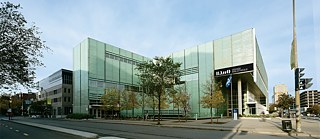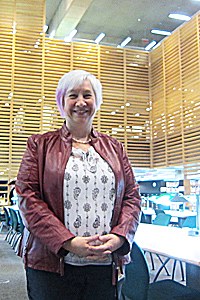Grand Bibliothèque (Bibliothèque et Archives nationales du Québec)
In the heart of Montreal, a cathedral of knowledge

In the era of digitization, the impending death of public libraries has often been announced. Faced with all these upheavals, they have managed to reinvent themselves, and the Grande Bibliothèque, located in Montreal, is a fine example of success and popularity.
By André Lavoie
Once known as the city of a hundred steeples, Montreal had more Catholic churches than libraries, reflecting a Quebec where religious fervour surpassed that of reading. It must be said that Quebec society has long maintained a neurotic relationship with knowledge, the province having already been led by a premier, Maurice Duplessis (1890-1959), always ready to boast of his having "never read a book". And imagine the reaction of American billionaire Andrew Carnegie when, at the turn of the 20th century, Montreal authorities refused his $500,000 donation for the construction of a public library worthy of this designation. Westmount, a small wealthy city with an English-speaking majority located in the heart of the Quebec metropolis, has owned its own since 1899....
The Quiet Revolution of the 1960s fostered a historical catch-up in terms of school enrolment and literacy, and libraries still play an essential role today. In 1961, barely 6% of the Francophone population had access to a library; by 2005, the rate had risen dramatically to 91.5% according to the Institut national de la recherche scientifique.
2005 was also the year of the inauguration of the Grande Bibliothèque du Québec, the long-awaited merger of the Bibliothèque Centrale de Montréal, then facing Parc Lafontaine, and the Bibliothèque Nationale du Québec, whose collections were spread throughout the city. In 2006, it was the turn of the Archives Nationales du Québec to form the Bibliothèque et Archives Nationales du Québec (BAnQ).
What was to become a Quebec variation of the famous Staatsbibliothek in Berlin sparked heated debate when it was announced by Lucien Bouchard's PQ government in 1997. Covering 33,000 square meters and developed at a cost of $1 million, it was regarded as an outdated extravagance. Some called it a cultural Olympic Stadium (the ultimate insult after the Montreal Olympic deficit in 1976!) others the death knell of the ill-functioning network of neighbourhood libraries. Many believed it to be the whim of the former director of the newspaper Le Devoir, Lise Bissonnette, who already defended the idea in her editorials in the mid-1990s before becoming its first CEO.
Judging by the figures, the follow-up proved them largely wrong. Located in the heart of the Quartier Latin between two educational institutions and above one of the busiest metro stations in the network, the Grande Bibliothèque was quickly inundated: 35 million visitors since its opening, 7500 per day in 2017-2018. With access to 2,3 million documents of all kinds (books, DVDs, CDs, video games, etc.) from the universal collection, and 1,3 million from the national collection. The two collections being grouped under the same roof was an innovative model at the time; several countries and cities are now drawing inspiration from it.
The digital challenge

The digitization of collections is progressing well (almost 30 million titles of all kinds, from books to cultural periodicals to maps), but the task is far from completed. "We have the same challenge as all other cultural institutions," says Jean-Louis Roy. “How to settle into the digital civilization? It is not only an extension of the physical library; it is another world with its own rules and standards.”

"We are receiving people interested in enriching this encyclopedia," says the librarian. By presenting the scope of our resources, users will be able to add reliable, credible sources and correct erroneous information. We even suggest pages to create. What we want is to promote Quebec, and French-speaking Canada, on the Internet. A long-term task. »
Moreover, the virtual does not hinder BAnQ's plans for geographical expansion- since 2016 the institution has become the guardian of the imposing Bibliothèque Saint-Sulpice, located on rue Saint-Denis, which for a long time was the main focus of the National Library, but has been abandoned for several years. Intended to become a state-of-the-art laboratory library, this $24 million project has not yet been completed, as $3 million has yet to be found from private partners. "When I'm not in my office, I solicit a lot of people for this project," says Jean-Louis Roy. Rehabilitation is a major technical challenge. "Everything is heritage in this magnificent building [in the Beaux Arts style designed by Eugène Payette and inaugurated in 1914], from furniture to stained glass windows and lamps.”
Sometimes a victim of its success

Despite these problems, the success did not wane, gathering an admirably loyal and devoted base. This is the case of Jean-Philippe Gravel, a film critic and French teacher who has been frequenting the area since it opened. To establish his reading choices, he regularly consults the portal, but also does not hesitate to stroll between the shelves or in front of the thematic displays ("That's how I discovered the French writer Philippe Muray.").
He, who has seen this place transformed over time, appreciates the richness of its

As for Jean-Philippe, with his hundred loans on an annual basis, and nearly 2000 since its opening, he does not have to be convinced of the relevance of this cathedral of knowledge in ensuring Quebec's intellectual fervor.